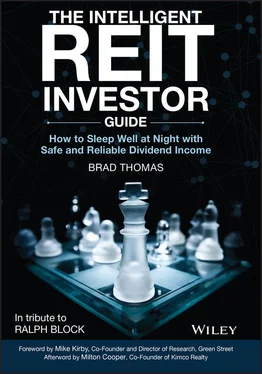These private partnerships can be good investments at times under the right conditions with the right partners. But they still don't stand up to REITs more often than not.
Publicly Traded Limited Partnerships
Publicly traded real estate limited partnerships were once very popular, which was largely a shame. In the 1980s, these entities plucked billions of dollars from investors seeking the benefits of real estate ownership combined with tax breaks. The end result was their victims were lucky to recover 10 or 20 cents on the dollar.
There were several reasons for this failure, including the fees that were sometimes so high that they demolished all potential profits for the little guy. Often, there were conflicts of interest going on with the general partners. And in other cases, they bought into the real estate cycle too late. After grossly overpaying for properties, they hired mediocre managers, failing to recognize that real estate is a very management‐intensive business.
As a result, publicly traded limited partnerships aren't popular today. Nor should they be.
The Private REIT Phenomenon
Beginning in 2000, another real estate alternative to public REITs burst onto the scene – non‐publicly‐traded, or private, REITs. Exactly as their names suggest, these entities comply with U.S. REIT laws but don't trade in public markets. Sponsored by various real estate organizations, they're usually sold to small investors by financial planners and investment advisers.
Like their public counterparts, private REITs will own a collection of commercial properties and distribute the resulting income to their shareholders as dividends. But they operate more as accumulators and aggregators of assets than vertically integrated operating companies. Their yields can be fairly high, though that doesn't make them automatically superior.
These investments actually come with a number of drawbacks. Perhaps most important is their lack of liquidity. And that's true even when they make offers to repurchase certain amounts of shares at certain times under certain conditions, as some of them do. Shares still can't be quickly sold by calling one's broker or pressing a button.
Furthermore, nonpublic REIT shares are usually sold with large commissions – often over 10% – that go to the selling agent. That means fewer investment dollars are available for real estate investment. Or for real estate investors. Too often, the corporate sponsor also earns significant additional revenue via property acquisitions and management fees. So there can easily be conflicts of interest and attempts to grow the REIT for exclusive gains instead of mutually shared benefits.
Investors should therefore carefully analyze these entities’ organizational structures, balance sheets, acquisition criteria, operating costs and fee payments, prospective cash flows, and dividend coverage from recurring free cash flows.
Privately held REITs, privately held property, bonds, preferreds, utilities, MLPs, and the like can and do provide alternatives to REIT investing. But that doesn't make them replacements.
Publicly traded REITs focus entirely on commercial real estate, and their stocks have both liquidity and reasonable prospects for capital appreciation over time. Because of their structure, their management teams tend to hold closely aligned interest with shareholders. And their financial conditions and operating results are quite transparent via Securities and Exchange Commission (SEC) disclosure requirements and industry practices.
The key point is this: Publicly traded REIT shares are unique and distinguishable from other higher‐yielding investments, including other forms of commercial real estate ownership. As such, it doesn't need to be an either/or choice. A wise investment strategy is to own both REITs and other higher‐yielding stocks along with other investments. You should always strive for the right investment mix for your personal financial situation, tolerance, and goals … all of which we'll discuss going forward.
CHAPTER 3 REITs over the Decades
“Investing isn't about beating others at their game. It's about controlling yourself at your own game.”
—Benjamin Graham
As we discussed briefly in Chapter 2, few assets are more illiquid than commercial real estate such as office buildings, shopping centers, apartments, and the like. They're also very expensive to own and operate, which made them a “boom and bust” business in the past. Fueled by unreliable information (or at least a serious lack of good information), fortunes could be lost on these purchases.
Then again, fortunes could also be made – provided one already had a small fortune to begin with. Commercial real estate was the quintessential “you've got to have money to make money” example before the mid‐twentieth century. It was a wealthy man's game until REITs came along.
The concept was really spawned by a real estate management company in Boston, Massachusetts, that used a business trust vehicle to avoid paying double taxes on its holdings. It was ultimately taken to court over this, with the court's decision basically boiling down to “if it walks like a duck and acts like a duck, it's probably a duck.” And so ended the earliest REIT ancestor.
Yet that defeat prompted a new battle as the same company hired a law firm – Goodwin Proctor – to design a vehicle that would be legally acceptable. This time, it met with success. Congress accepted the accurate argument that small investors were unable to benefit from commercial real estate investing. As such, it agreed to allow a new business classification using mutual fund rules as a model.
(Interestingly, that's why REITs originally had to involve outside property managers: because the company that created them was precisely that. Self‐interest, right? It's a beautiful thing.)
REITs were officially defined and authorized by Congress in the Real Estate Investment Trust Act of 1960, and the first actual examples were organized that same year under the following understanding:
1 A REIT must distribute at least 90% of its annual taxable income, except for capital gains, as dividends to its shareholders (most pay out 100%).
2 A REIT must have at least 75% of its assets invested in real estate, mortgage loans, shares in other REITs, cash, or government securities.
3 A REIT must derive at least 75% of its gross income from rents, mortgage interest, or gains from the sale of real property. And at least 95% must come from these sources, together with dividends, interest, and gains from securities sales.
4 A REIT must have at least 100 shareholders with less than 50% percent of the outstanding shares concentrated in the hands of five or less shareholders.
The concept was pretty popular right out of the gate. Some of the earliest to go public were Washington, Pennsylvania, and Bradley REITs (the latter of which was not named after me) – small companies for small investors who only wanted to buy up 10, 100, or 1,000 shares. A large number of other equity REITs queued up for their IPO (initial public offering) spotlights as well. But the assassination of President John F. Kennedy in 1963 threw the markets into turmoil, permanently pushing most of those debuts back.
It was a major setback to the sector's early evolution.
According to The REIT Investment Summary , a 1996 report published by Goldman Sachs, there were really only 10 of these businesses worth noting in that first decade. The companies in question ran portfolios worth $11 million to $44 million, and many of them were attached to management companies that were affiliated with members of their boards. It goes without saying that this could and did too easily create issues.
Читать дальше












